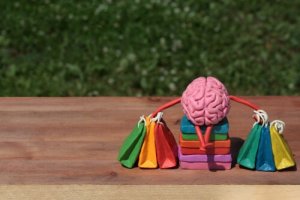Five Psychological Strategies Used in Marketing


Reviewed and approved by the psychologist Gema Sánchez Cuevas
To buy or not to buy, that is the question. Big brands can’t give consumers too much leeway. This is why they’re experts on the psychological strategies used in marketing. Usually, big companies don’t let too many random variables get in their way. In fact, if it were for them, there wouldn’t be any variables at all. Their marketing campaigns are carefully thought out to make you want to buy their products.
But in order to make you buy what they offer, they must know what you want, what you need, and how you want it. They study the consumer and apply psychology to marketing.
The psychological strategies used in marketing
Impulse is something extremely important in the purchasing process. In a study carried out by Chase, Gallup, and Harris Interactive, a series of psychological strategies used in marketing by big advertisers to stimulate impulse purchases were identified.
Our brain makes connections in order to make impulsive decisions. So whether you plan to buy something or feel like buying it in the “heat of the moment”, you’ll always find signs like “Buy now!”, “Get a subscription now!” Do you think it’s a coincidence? Think again.
Studies on the psychology of marketing (or neuromarketing) prove that our instinctive demands play an important role when our brain looks for reasons to buy one product or the other. In other words, instinct makes us choose, and choose fast. Experts know this, and that’s the reason why they often play with our “fear of missing out on a good deal”, which is that fear that arises when they tell us there are only a couple of items left.
Big and small advertisers rely on their knowledge of our minds (they try to make consumers think less) to launch their campaigns or show us a certain product. They know that emotions play a vital role in most of the decisions we make. We’re emotional beings who think.
Use of images
Few advertisement companies overlook the visual aspect. Our brain processes images faster than text. That’s why they’re very important in the purchasing process.
A high-quality image is an amazing ally when it comes to ads. Advertisers always look to make a powerful visual impact, one that makes potential consumers think they’ll be happier, more successful, or more elegant after buying their product or service.
Use of color
So you think that the colors in a marketing campaign are random or used because they look “pretty”? The truth is that there’s so much more behind it.
Have you noticed all the blue on platforms like Twitter, Facebook, PayPal, or Microsoft? It’s obviously not random. According to studies on the psychology of colors, blue looks reliable and inspires the user to engage with the product because they feel safe doing it.
This is why most advertisers try blue first when they design their psychological strategies for marketing. As we already mentioned, it’s not random at all. It has to do with culture, experience, and a combination of the two.
The first “yes” is the most important
One common neuromarketing strategy is gradually raising the price of a service over time. Maybe it’s hard for us to pay $100 for a service, but it’s not as hard if we were already paying $90. The key is to raise the price little by little, so the consumer doesn’t think about turning to the competition.
Once you’ve said your first “yes” to the product, you’re more likely to keep buying it in the future. This is a strategy that’s based on gaining the consumer’s trust. It’s called inbound marketing.
Many big brands no longer aim to make a powerful and on-the-nose impact. Now, many aim for that first “yes”, a fantastic opportunity to earn the consumer’s trust and slowly offer them content until they want to buy their product.
“Make a customer, not a sale.”
-Katherine Barchetti-

The anchoring effect
Even if you want to see many versions of a specific product, the first ones will be your point of reference to say whether the others are cheaper or more expensive. For instance, in some stores, sales associates will tell us about their products starting from the most expensive ones.
Along with the anchoring effect, advertisers also want those first products to catch our attention. Our brain tends to remember the first and last elements of a list more easily, so they try to take advantage of this by putting the products they want you to buy at the beginning or at the end of an advertisement.
Emotions
Without a doubt, many of the main psychological strategies used in marketing appeal to our emotional side. Neuroscience proves that a last-minute purchase is still an impulsive purchase.
That’s how the marketing gurus try to make us notice their campaigns. In order to be more and more effective every day, they study the market, its trends, tendencies, and motivations. We’re the market and we’ll always be their targets!
To buy or not to buy, that is the question. Big brands can’t give consumers too much leeway. This is why they’re experts on the psychological strategies used in marketing. Usually, big companies don’t let too many random variables get in their way. In fact, if it were for them, there wouldn’t be any variables at all. Their marketing campaigns are carefully thought out to make you want to buy their products.
But in order to make you buy what they offer, they must know what you want, what you need, and how you want it. They study the consumer and apply psychology to marketing.
The psychological strategies used in marketing
Impulse is something extremely important in the purchasing process. In a study carried out by Chase, Gallup, and Harris Interactive, a series of psychological strategies used in marketing by big advertisers to stimulate impulse purchases were identified.
Our brain makes connections in order to make impulsive decisions. So whether you plan to buy something or feel like buying it in the “heat of the moment”, you’ll always find signs like “Buy now!”, “Get a subscription now!” Do you think it’s a coincidence? Think again.
Studies on the psychology of marketing (or neuromarketing) prove that our instinctive demands play an important role when our brain looks for reasons to buy one product or the other. In other words, instinct makes us choose, and choose fast. Experts know this, and that’s the reason why they often play with our “fear of missing out on a good deal”, which is that fear that arises when they tell us there are only a couple of items left.
Big and small advertisers rely on their knowledge of our minds (they try to make consumers think less) to launch their campaigns or show us a certain product. They know that emotions play a vital role in most of the decisions we make. We’re emotional beings who think.
Use of images
Few advertisement companies overlook the visual aspect. Our brain processes images faster than text. That’s why they’re very important in the purchasing process.
A high-quality image is an amazing ally when it comes to ads. Advertisers always look to make a powerful visual impact, one that makes potential consumers think they’ll be happier, more successful, or more elegant after buying their product or service.
Use of color
So you think that the colors in a marketing campaign are random or used because they look “pretty”? The truth is that there’s so much more behind it.
Have you noticed all the blue on platforms like Twitter, Facebook, PayPal, or Microsoft? It’s obviously not random. According to studies on the psychology of colors, blue looks reliable and inspires the user to engage with the product because they feel safe doing it.
This is why most advertisers try blue first when they design their psychological strategies for marketing. As we already mentioned, it’s not random at all. It has to do with culture, experience, and a combination of the two.
The first “yes” is the most important
One common neuromarketing strategy is gradually raising the price of a service over time. Maybe it’s hard for us to pay $100 for a service, but it’s not as hard if we were already paying $90. The key is to raise the price little by little, so the consumer doesn’t think about turning to the competition.
Once you’ve said your first “yes” to the product, you’re more likely to keep buying it in the future. This is a strategy that’s based on gaining the consumer’s trust. It’s called inbound marketing.
Many big brands no longer aim to make a powerful and on-the-nose impact. Now, many aim for that first “yes”, a fantastic opportunity to earn the consumer’s trust and slowly offer them content until they want to buy their product.
“Make a customer, not a sale.”
-Katherine Barchetti-

The anchoring effect
Even if you want to see many versions of a specific product, the first ones will be your point of reference to say whether the others are cheaper or more expensive. For instance, in some stores, sales associates will tell us about their products starting from the most expensive ones.
Along with the anchoring effect, advertisers also want those first products to catch our attention. Our brain tends to remember the first and last elements of a list more easily, so they try to take advantage of this by putting the products they want you to buy at the beginning or at the end of an advertisement.
Emotions
Without a doubt, many of the main psychological strategies used in marketing appeal to our emotional side. Neuroscience proves that a last-minute purchase is still an impulsive purchase.
That’s how the marketing gurus try to make us notice their campaigns. In order to be more and more effective every day, they study the market, its trends, tendencies, and motivations. We’re the market and we’ll always be their targets!
This text is provided for informational purposes only and does not replace consultation with a professional. If in doubt, consult your specialist.







